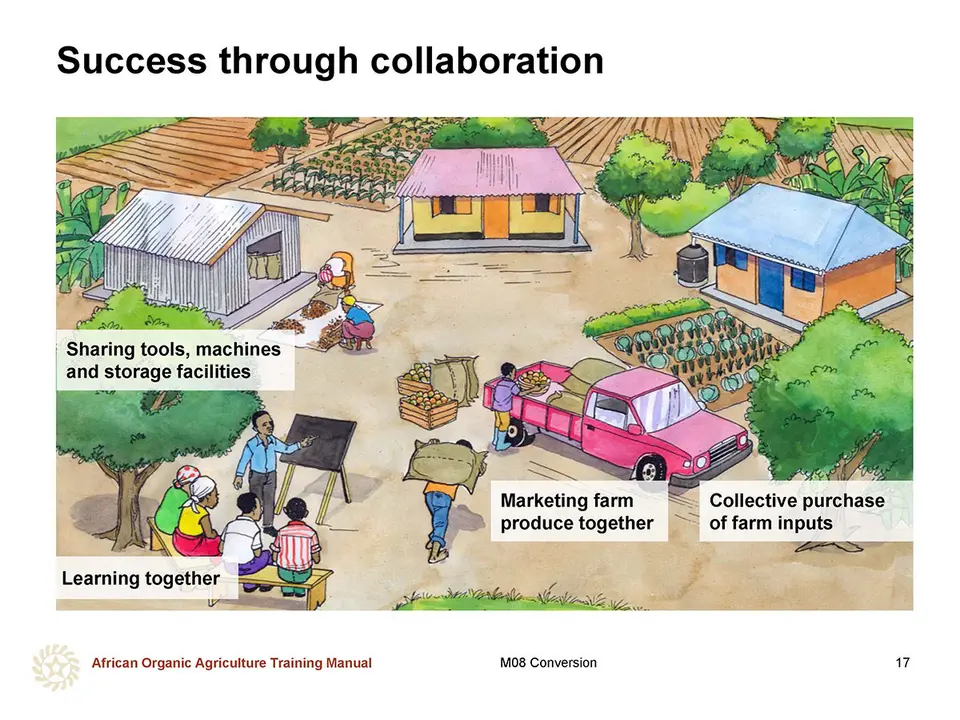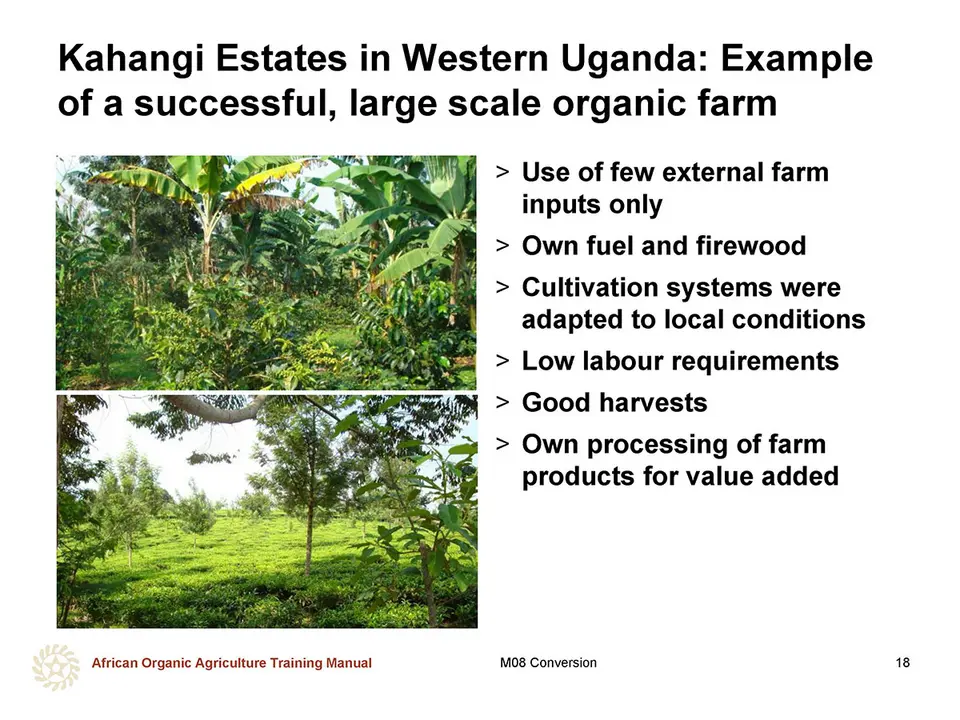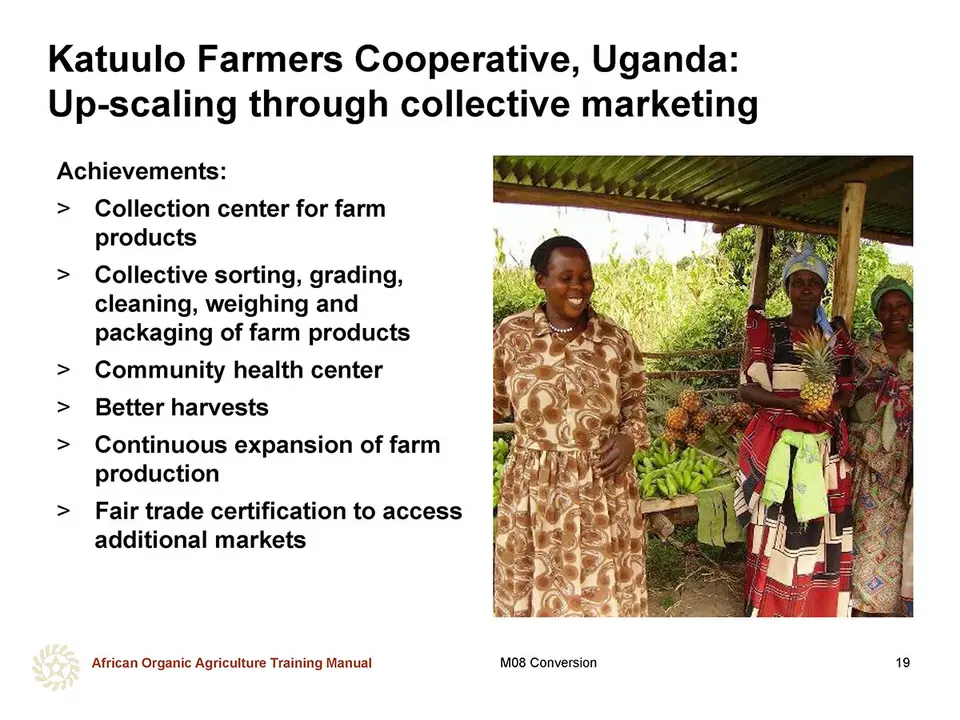Scaling up organic production
Although organic farming originated as a small-scale enterprise in family gardens and operations from under 1 acre to 10 acres, today large scale organic farms exist also in Africa, requiring machinery and equipment similar to other large scale farms. Large scale production is more attractive to big buyers and easily attracts support from governments and other funding institutions. In fact, the market offers increasing opportunities for scaling up organic production.
Of course scaling up does not only mean increasing the farm area. This is–in many cases–not possible. There are different scenarios how farmers can increase production:
a. Small-scale farmers willing to expand their production without land constraints should expand production proportionately to the available resources and the market opportunities. Such farmers should remember that increasing the area of production implies more resources to manage (seeds, labour, mechanization, capital, etc.) and to market the excess production.
b. Small-scale farmers with limited land for expansion, as they are common in hilly areas, can work together with other farmers in a group to either consolidate the smaller units of land into large units or pool the harvests from the individual farmers to make larger volumes. Then the large volumes are marketed collectively.
c. Large-scale farmers might need to start by applying organic practices on selected plots only to minimize risks and to gain experience. They then can progressively convert the entire farm to organic farming.
d. Scaling up is also possible with diversification and intensification of a farm. For example, intercrop fruit production with vegetables produce several crops on the same surface.
Discussion on options for increasing the farm size
Discuss and compare the different options for increasing the size of organic farms. What are the potential and risks of the different options from the farmers’ perspective?
Case study: Kahangi Estate in Fort Portal, Uganda - An example of large-scale organic farming
Kahangi estate is a private and commercial farm, located in Western Uganda 14 km northeast of Fort Portal Town at an altitude of between 1,450 to 1,550 meters. The estate comprises 93 acres of tea, 24 acres of Arabica coffee, intercropped with bananas, 36 acres of woodlots and 6 acres of essential oil crops, while the rest of the land is left for grazing and natural wetlands.
The estate has developed its own system of organic management based on permaculture principles where all the necessary inputs for crop production are developed on-farm. The zone 1 crops comprise coffee, bananas, and oil crops, zone 2 is comprised of tea, and zone 3 and 4 comprise woodlots and grazing areas. The estate has focused on developing a fertile soil, maintaining an environment conducive for microorganisms (with proper soil moisture and temperature), and a system of minimum tillage was adopted. In 2005, a program for establishing windbreaks around the farm and intercropping all the crops with trees began. This supported a steady decline in average wind speeds, which led to a decline in evapo-transpiration rates. This also reduced the need to water crops, thus reducing energy use and labour time.
In 2004, the estate developed on-farm processing facilities for the production of body care products and edible oils. It processes own oil seeds together with purchased seeds that cannot be produced on the farm. The bulk of the firewood comes from the management of shade for the tea and coffee and also from own wood lots. The processing waste, which includes seed cake waste, ash from the distillation of essential oils and crop trashes, is used to enhance soil fertility as is the extensive use of cover crops such as Mucuna and Dolichous for the coffee and Canavalia spp for the tea. Subsequently soil fertility is now maintained by careful management of the soil to enhance microbial activity. Trials are being conducted with the introduction of microorganisms, specifically nitrogen fixing bacteria extensively used on the tea and mycorrhizal fungi used for the coffee.
The estate uses solar power, supported by a generator, in its processing activities. The generator is powered with biodiesel produced from the seeds of some of the shade trees such as Alurites mulucanna and Croton. Also, the waste from biofuel production is used as a fertilizer.
The system of organic farming developed by the estate is not labour intensive, has given a substantial cost savings. For example, organic tea production is 10% lower than conventional production, but profitability of the tea has increased by over 20 fold because of the savings. The estate is increasingly being used by private commercial companies to train staff involved in the export of certified organic
Case study: Katuulo Farmers Cooperative in South-Western Uganda - An example of a farmer marketing initiative
Katuulo Farmers Cooperative is a group of about 25 farmer households, including men and women, located in Rakai district of Western Uganda. The farmers have been working together for more than 10 years, growing organic pineapples and apple bananas for export. The farmers are collectively certified under an ICS arrangement by an export company, Amfri Farms/African Organic, based in Kampala, since 1998. Together they harvest and collect the fresh pineapples and apple bananas from their individual farms, to a collection centre. Here they sort, grade, clean, weigh and pack the harvested produce according to Amfri requirements, either for fresh export or for dried fruit processing.
According to the chairperson of the group, Mr. Karenzi Atanazio, working together as a group has given them many benefits:
Using their own resources they were able to buy land and construct a collection centre together with an office, where their group documents are kept and trainings are held.
The group opened a bank account and is able to make savings from the deductions whenever members sell and also from annual membership contributions. Using part of these savings plus contributions from Amfri and its partners, the group has constructed a community health centre to serve the whole community.
Over the years of farming organically the productivity of their farms has greatly improved and all members now own their land and are continuously expanding.
Recently the group has also been certified fair trade under the Amfri ‘fair for life’ programme and they consequently expect to get a premium that will enable further development to take place.



 tap and then scroll down to the Add to Home Screen command.
tap and then scroll down to the Add to Home Screen command.